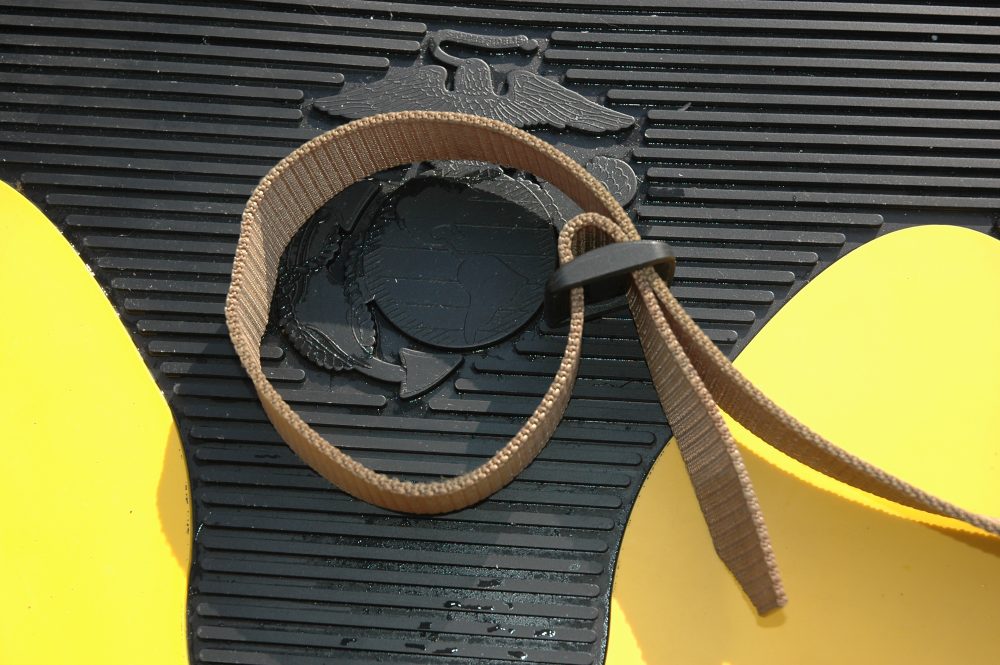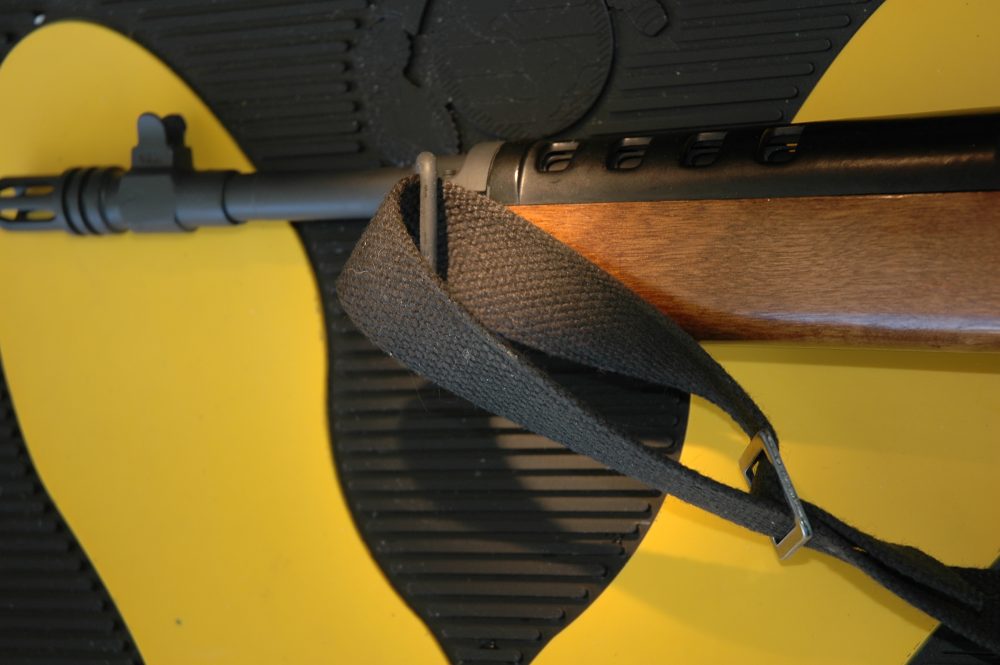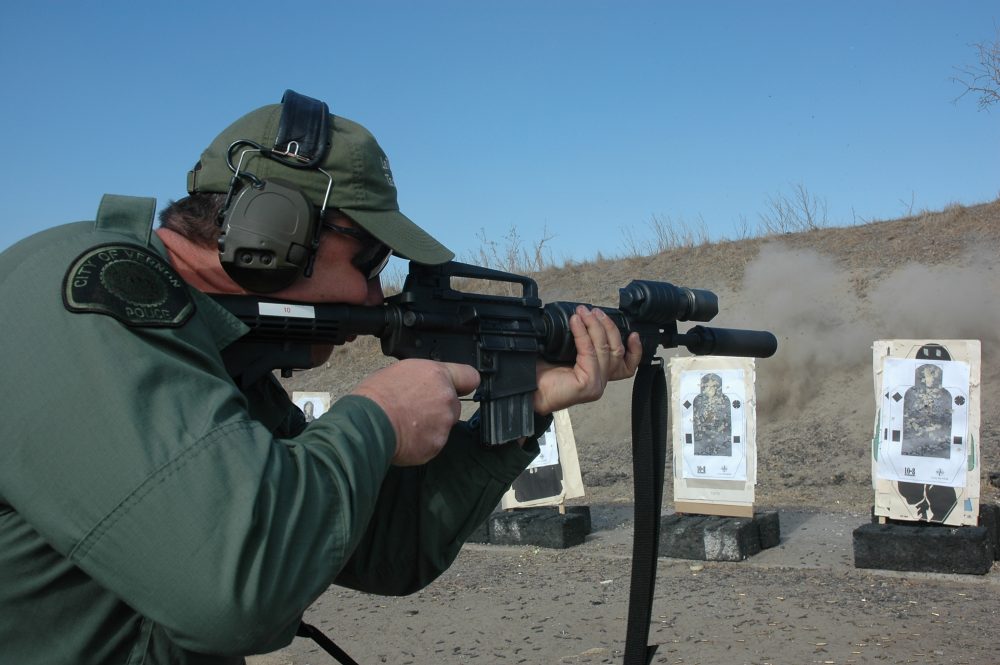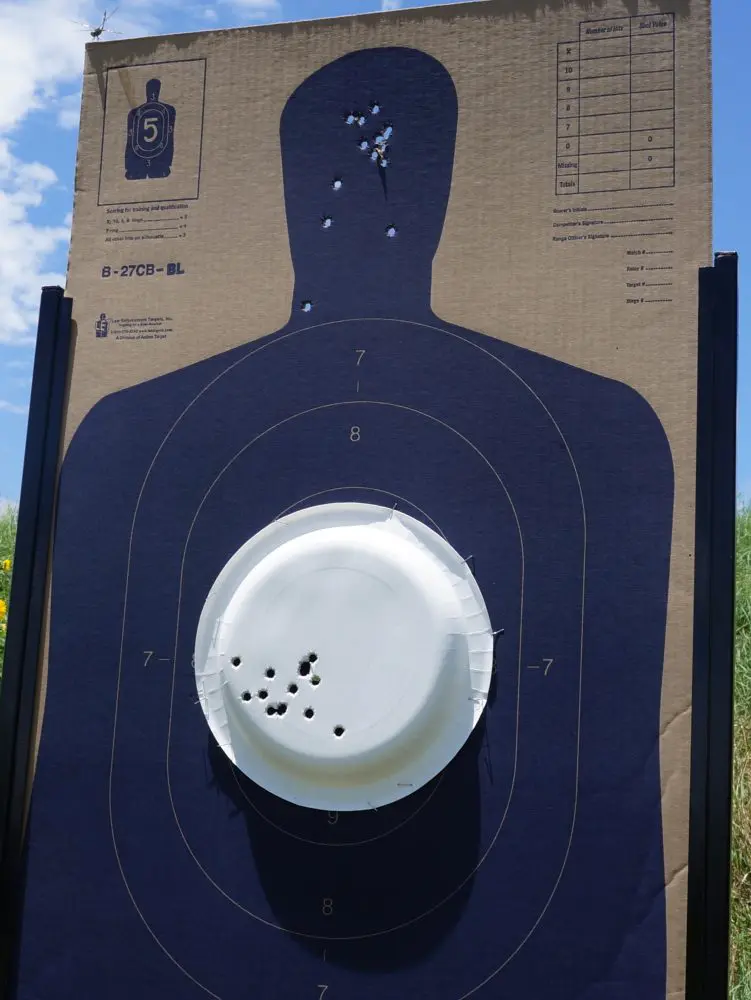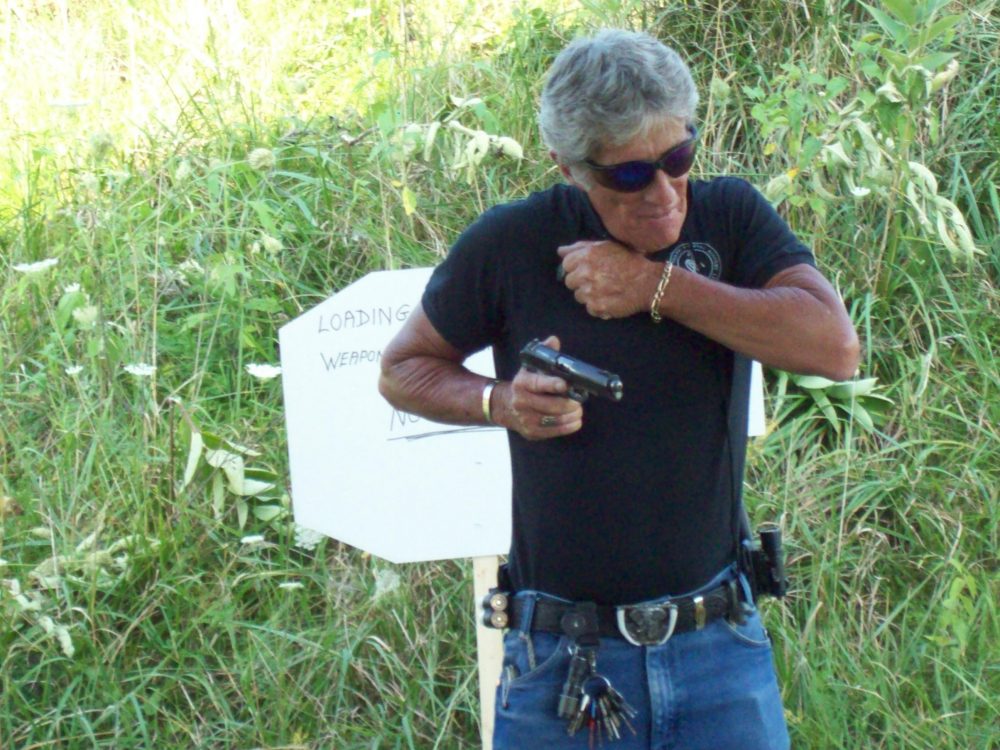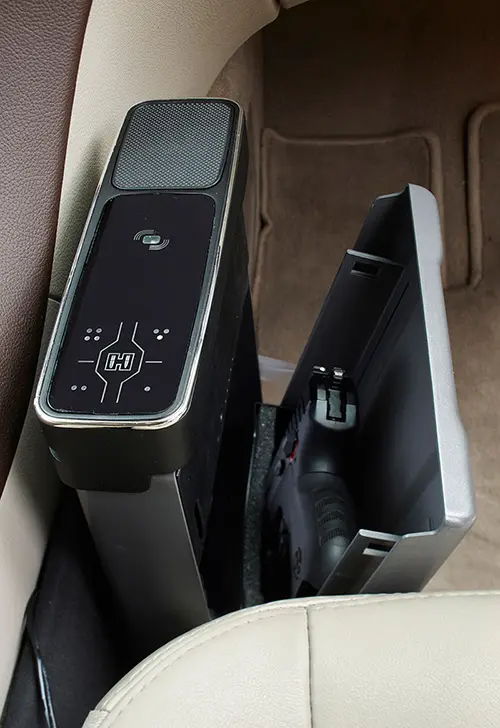Many of us have a choice as to what type of weapon/support equipment we use. However, there are also a great many people who are stuck with guns, support gear and other essential equipment that is dictated by those who may not have a clue.
One glaring example is a sling. That the sling is necessary shouldn’t be an issue. That many have no clue about slings is a given. Bean counters, administrators and (God help us) “police executives” make decisions based on nonexistent criteria that defies explanation and leaves people scratching their heads and stuck with less than optimal equipment. The big military was especially slow to recognize the deficiencies of the so-called parade slings, for reasons that are obvious but likewise shocking.
Modifying carry strap for rapid adjustment—forward end of sling is to the left.
1. Place running end of sling through upper loop of tri-glide buckle.
2. Run sling through upper sling swivel (not pictured).
3. Place running end of sling under buckle, then through lower loop of tri-glide buckle.
4. Place running end through upper loop of tri-glide buckle.
When I was still on the job, we had a requirement to carry a flashlight. The Firearms and Tactics Section recommended “The” light of the day, the old Kel-Light, stating that it could be used like any other impact weapon. Of course cops did exactly that, and complaints about cops using flashlights were common—apparently giving someone a wood shampoo was fine, but aluminum was somehow thought to be unfair.
The job restricted the size and battery capacity of the lights to be carried. To that end, the highest-ranking member of the Department struck a deal with a flashlight manufacturer to “give” a flashlight to all members. The result was that all the cops wound up with one of those cheap, chrome looking (but apparently made from a composite material that fell into the cardboard/tinfoil end of the spectrum) things that any real cop would be ashamed to use.
The end result was that they wound up at home or given away (we kept the batteries, though). I made a recommendation, complete with charts, pictures with circles and arrows and such, for adopting the SureFire 6P.
The reply was one line with the Department order number specifying the particular size/battery capacity authorized. Hey, don’t let facts conflict with theories—no matter how silly they may be.
Back to slings. There is an institutional hatred by some of anything called “tactical.” For whatever reason, this also applies to slings—maybe especially to slings.
Sling, Small Arms in parade position on Mini-14.
Even within the training community, there are those who believe that using a tactical sling is similar to Beelzebub infiltrating a prayer service.
In the late 1970s, a simple black nylon carry strap was issued to both the Army and the Marine Corps. While the proper nomenclature is Sling, Small Arms (NSN 1005 00 167 4336), wannabes and surplus dealers called it the “Silent Sling,” apparently to deceive naïve buyers into buying a genuine “black ops” article.
Sigh…
This sling had two metal tri-glide buckles which, if threaded as issued and commonly used, made rapid adjustment difficult to impossible.
Unfortunately this carry strap-type sling is still somewhat common, and used by some departments due to financial issues or a lack of common sense.
A long time ago an instructor who apparently received most of his knowledge though late night AM radio talk shows made a number of strong statements about the uselessness of tactical slings. He was a proponent of the above-mentioned Sling, Small Arms, for reasons that escape me. He taught a system for using the carry strap sling, advocating a KISS principle for the sling that conveniently ignored the reality of a fight. His sycophants performed elaborate flowing hand motions, reminiscent of those performed by a Kabuki dancer. The purpose of this performance was to capture the swaying sling in your hand against the gun, to avoid snagging it on whatever. The motions were deliberate and focused, and took a lot of time to perform, thus negating the KISS principle—in spades.
Sling, Small Arms in extended position on Mini-14, showing front sling swivel. This isn’t a perfect fix, but it is better than what it was.
Question: How much time do you have in a gunfight?
Answer: The rest of your life.
Rhetorical question: Would you rather spend time folding a sling or launching projectiles at the person(s) launching projectiles at you?
The answer should be obvious, but apparently is not.
The gist of this time-consuming movement was to avoid catching the sling on something (though that “something” was never revealed). Slings can undoubtedly catch on some things—as can shoe laces, duty belts, clothing, mustaches and a host of other things.
However, folding the sling is the antithesis of economy of motion, and that particular drill may be viable only on a square range. This is a common error in much training, be it military, police or average earth people—the standard is qualification rather than competence, and the qual is often out of touch with reality. This becomes apparent in shoot house or field firing exercises, but especially in force on force training.
If you are stuck with one of these carry straps, there are alternatives. One is to use masking/paint-type tape to tape the sling folded for storage in a vehicle rack and so forth. If the sling needs to be deployed, simply break the tape, and you are good to go. However, once you take the carbine off your shoulder, you have that same old swaying sling.
For those who want a fix neater in appearance and to make an easily adjustable carry strap, you can follow the instructions below:
- Attach the sling to your buttstock and thread the sling through the lower tri-glide buckle as normal. Unthread the upper tri-glide buckle and remove it from the sling.
- Hold the sling with the lower end to the right and the upper end to the left.
- Feed the strap through the upper slot of the tri-glide.
- Make a loop, and pass the running end through the upper sling swivel.
- Bring the running end underneath the tri-glide buckle.
- Pass the running end up into the lower slot of the tri-glide buckle, and back through the upper slot.
- Make sure that there are 2-3 inches of sling protruding through the tri-glide buckle.
Pressure on the sling will lock it up. To unlock the sling for adjustment, simply pull down on the lower part of the tri-glide buckle and slide it along the sling until you are satisfied. It is easily done one handed, reducing the amount of hand jive necessary.
You can adjust the sling tight (parade position) for when it is stored in the rack. If you have to deploy the carbine, it will be out of the way. If you need to administratively sling the gun, loosen the tri-glide to the proper position and have at it. If you take it off your shoulder and have the time, you can tighten it up with your support side hand.
Understand that you still won’t have a perfect sling. The best you can say is that you are picking up a turd by the clean part.
This very accomplished shooter has the Sling, Small Arms on his suppressed AR. While he would normally fold the sling, in this case he did not. Length of sling is obvious, and may not be beneficial. There are better alternatives than this carry strap.
Once the sling is loose, it will flop around until you change its orientation. If you have to transition to a pistol, you will need to drop the long gun. The nonsense of looping it around your neck or over your arm just means that your priorities are grossly out of whack. If the #1 gun goes down, you need to get a loaded, working gun in your hand, right now. If you are futzing around trying to make a useless sling work (after a fashion), you are wasting time (refer back to the “how much time do you have in a gunfight” question, above). That time would be much better spent getting your blaster into your hand and depressurizing the bad guy’s circulatory system.
The tactical sling—of most types and manufacturers—would be a significantly better choice than the carry strap sling.
While the single-point sling is useful for CQB, the three-point—the original tactical sling—has lost its primacy and is being replaced by the tactical two-point sling.
The problem with the carry strap is that they were designed for one purpose—to administratively carry the carbine. To that end they were made to a specific length and no longer.
Trying to use the two-point sling as a tac sling led people to mate two slings together or utilize field expedient slings that were significantly longer. The longer sling permitted users to assume prone or intermediate positions, but hung too low while standing upright. There was no free lunch.
It wasn’t until Kyle Lamb came along with his Viking Tactics VTAC sling that permitted users the ability to rapidly lengthen/shorten their slings according to need. The VTAC is a true general-purpose tactical sling.
In the overall scheme of things, the mindset of the individual may be the reason why some people always win, and others will lose—once. However, there comes a point in time when some will achieve a level of expertise at which better equipment enhances combat efficiency. Ergonomics, “knobology,” improved sighting systems and more useful slings, load carriage and armor will mean that the shooter can more immediately sort out his opponents.
My good friend and coworker Jonny Laplume—who may know more about this particular subject than 99% of the people walking the face of the earth—often states “Fight the enemy, not your equipment.”
I’ll modify that just a little and state that you should fight the enemy, and specifically in this case, not your sling.
What works on the square range may have little application on the two-way range. What bean counters acquire under the guise of fiscal responsibility may be criminally negligent when applied for real.
Research your requirements carefully. Then buy the absolute best equipment that you can. Seek out the best training that you can to sort the gear out.
And when you are finished, train some more.
[Pat Rogers is a retired Chief Warrant Officer of Marines and a retired NYPD Sergeant. Pat is the owner of E.A.G. Inc., which provides services to various governmental organizations. He can be reached at [email protected]]
SOURCE:
Viking Tactics
Dept. S.W.A.T.
910-987-5983
www.vikingtactics.com

